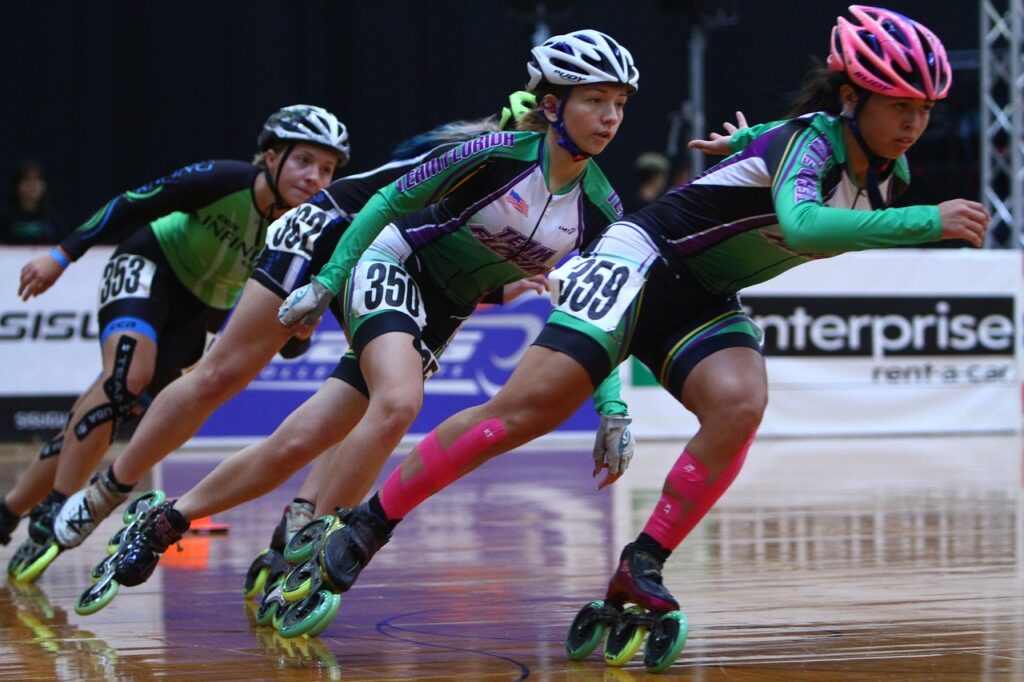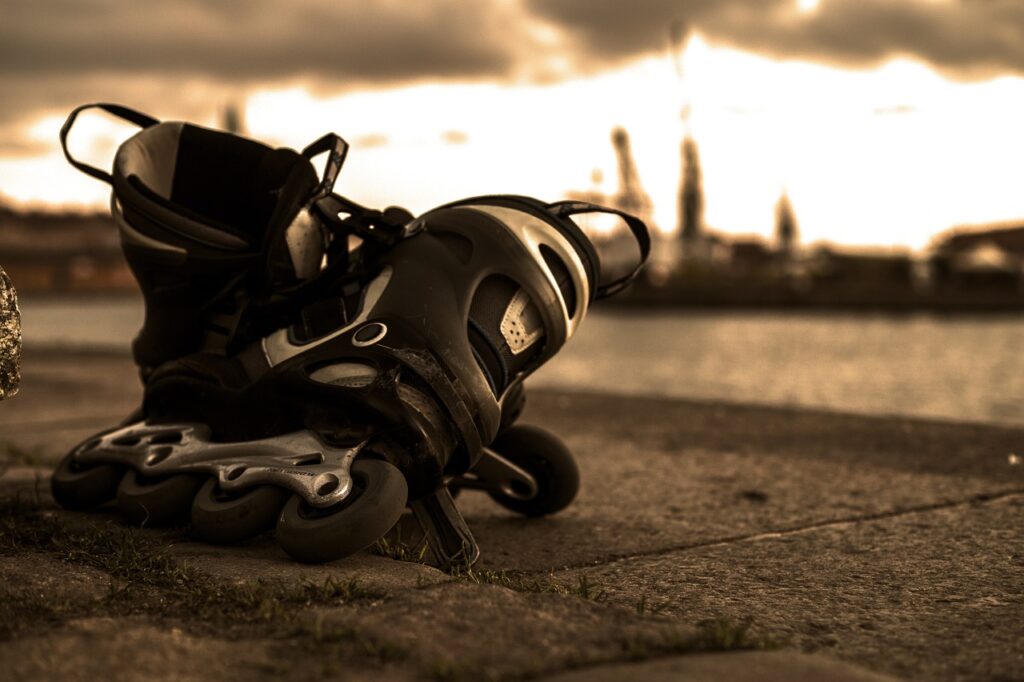Introduction – Inline and Rollerskating Drills
Roller skating is a great workout, but you can improve your skating skills even more by checking out some roller skating drills. Roller skating as a whole may not be the best way to improve your coordination, stamina, and speed, but focusing on specific areas can have a significant impact. When they first start skating, most beginners prioritize leg strength.
Skating requires more than leg muscles – Skating requires a lot of leg strength, so there’s nothing wrong with that. However, your performance may suffer if you overlook the significance of other muscles. Here are five exercises to incorporate into your routine for an excellent all-around workout that will boost your performance on the rink.
5 Roller Skating Drills To Improve Your Skills
Lunge Stretches
We know that we just claimed that skaters already expend a significant amount of their energy on their lower body, but you absolutely cannot pass up the opportunity to reap the advantages of this stretch. When it comes to skating, gaining strength is essential; however, improving your flexibility might be just as significant.
- Position yourself in a deep lunge kneeling with your front leg bent at a ninety-degree angle and your back knee flat on the floor.
- Raise your arms in a straight line above your head, bringing them in close to your ears.
- Raise your bent back knee off the floor. You need just stretch till you feel a gentle pulling in your hips.
Bicycles
A back-breaking roller skating routine? Yes, you’re right. Skaters who participate in more fast-paced roller sports, such as derby or rhythm skating, especially benefit from strengthening their cores. Balance and stamina can be enhanced with the help of this core-strengthening routine.
- In preparation for a set of sit-ups, lie on your back with your hands behind your head.
- Raise your legs in the air, your left knee touching your right elbow and your right leg extended at a 45-degree angle to the floor.
- To do this, slowly rotate your core and switch the position of your legs and elbows so that your right knee is touching your left elbow.
- Do this exercise again.
Planks
This full-body routine requires very little preparation and can be modified to accommodate any fitness level.
- Stand with your feet shoulder-width apart and your hands under your shoulders to perform a push-up.
- Check your posture and make sure your hips aren’t sagging or popping up.
- Continue to keep your form in this stance for as long as you can.
Glute Bridges
While the gluteal muscles take a beating during roller skating, they are rarely the focus of home training for skaters. This could be due to the belief that skating itself provides sufficient exercise. However, you should focus more on your glutes because they provide you with a more forceful push and better endurance in your skating stride.
- Lay flat on your back with your arms resting at your sides and your legs extended out in front of you, knees bent, and heels resting near your butt.
- Raise the foot of one leg straight overhead, so that it forms a right angle with the floor.
- Methodically lift your hips until your body is in a straight line from your shoulder to your knee.
- You can repeat this process with the other leg.
Jump Squats
Squats are not only beneficial for your thighs and buttocks; they also strengthen your feet and calves, which are often overlooked. The extra work of hopping helps to strengthen those muscles and improves balance while skating.
- You should be standing with your feet about shoulder-width apart and your arms outstretched in front of you as if you were reaching for something.
- Squat down low, but don’t let your shins cross your feet.
- Jump as high as you can by using your arms to swing down toward your body as you rise.
- When you land from a leap, land softly at the knees and instantly sit back into a squat.
- Continue this safe movement indefinitely.
See Also: What Are The Best Rollerblades For Beginners?
Rollerblading Drills:

1. Agility Drills: Agility as a roller skating drill help you build coordination, responsiveness, and balance while on the rink. Start by finding a flat surface that’s free of obstacles, then begin skating in a snake-like pattern – make sure to change directions quickly and frequently. You can also weave back and forth or form an “8” with your body as you skate.
2. Stair Climbing: Stair climbing is one of the best ways to increase leg strength and improve endurance while rollerblading. Find a safe set of stairs to climb (preferably at least five steps) then use them as part of your regular rollerblading routine by going up and down the stairs for about 10 minutes each session.
3. Interval Training: This is a great way to increase your speed and power while rollerblading. Choose a distance of about 50 meters, then start with a light jog for the first 10 meters, then sprint for the next 10, followed by a slow jog for the next 10, and so on until you reach the end.
4. Jumping Drills: Just like any other sport or activity, jumping drills are essential when it comes to improving performance while rollerblading. Start with simple two-footed jumps in both directions (forward and backward) and then gradually progress to single-foot hops as well as one-foot jumps over an obstacle such as cones or steps.
5. Core Stability: The core muscles are essential for proper balance, coordination, and stability while rollerblading. To specifically target these areas while skating, try “planking” or side planks on the ramp. Hold each position for 30-60 seconds before switching sides.
Related: Are Roller Blades With 3 Big Wheels Better Than Small Wheels?
How To Stride
Roller skating is all about balance, coordination, and technique. With the proper stride, you can maintain your speed and agility on the floor with ease.
Step 1: Start by keeping your feet parallel and just outside of your shoulder width apart. Keep your knees slightly bent.
Step 2: Push off from one leg and let the other follow through in a circular motion to gain momentum for the next push-off. This should be done as quickly as possible while also avoiding any unnecessary energy expenditure during the process.
Step 3: Once you have gained enough momentum with each stride, you can pick up speed by pushing harder off of each foot. Make sure that when doing this, you are still using your core to maintain balance and control.
Step 4: Keep your head up and look ahead of you. This will help you anticipate any changes in the terrain or obstacles that may be in front of you.
What Is Body Blading?
A kind of roller skating known as body blading places an emphasis on body control and actions that are very precise. Executing maneuvers in an artistic manner demand a combination of strength, balance, coordination, and agility on the part of the performer. Body blading is a form of inline skating that emphasizes fluidity and grace in each move, as opposed to the speed and strength that are associated with traditional inline skating.
Freestyle gliding (slides and grinds), street skating (spins, flips, and jumps), and rhythm skating are the three body-blading techniques that are practiced the most frequently (syncopated patterns). Each style is used as a means of expressing one’s individuality while simultaneously pushing the boundaries of what is possible with a set of skates.
Check This: What Is The Average Rollerblade Speed?
Inline Speed Skating Technique

Inline speed skating requires a different set of skills compared to traditional roller skating techniques. In inline speed skating, the skater must focus on achieving maximum speed while minimizing air resistance.
1: Start by keeping your feet shoulder-width apart to reduce drag and increase power transfer.
2: Use your arms to propel yourself forward with each stride instead of just relying on the legs for momentum. This will help you maintain a consistent pace without tiring out quickly.
3: Focus on pushing off the ground with your toes instead of your heels to maximize acceleration and leverage each stride.
4: Keep your head up and look ahead to anticipate any changes in terrain or obstacles that may be in your path.
5: Use a tuck position when going downhill or on fast sections of the track. This will help you maintain control over your speed and reduce air resistance.
By following these tips and practicing each technique, you can improve your roller skating skills significantly and gain an edge in competition. Whether you’re looking to become a master of body blading or want to get faster on the rink for inline speed skating, incorporating roller skating drills into your routine is essential for success.
Read Also: What Is A Speed Skater Exercise?
Conclusion
Roller skating is an enjoyable pastime that can help you get in shape and stay active. But if you want to take your game to the next level, incorporating roller skating drills into your routine is essential. These exercises target specific areas of the body and provide a structured way to improve your technique, balance, coordination, and overall performance on the rink. Whether you’re looking for ways to become more agile or trying to increase your speed with inline skating techniques, these exercises will help you reach your goals. So lace up those skates and let’s get started!